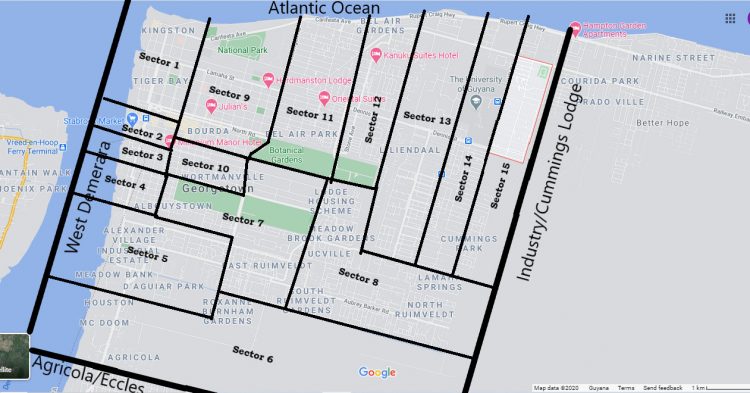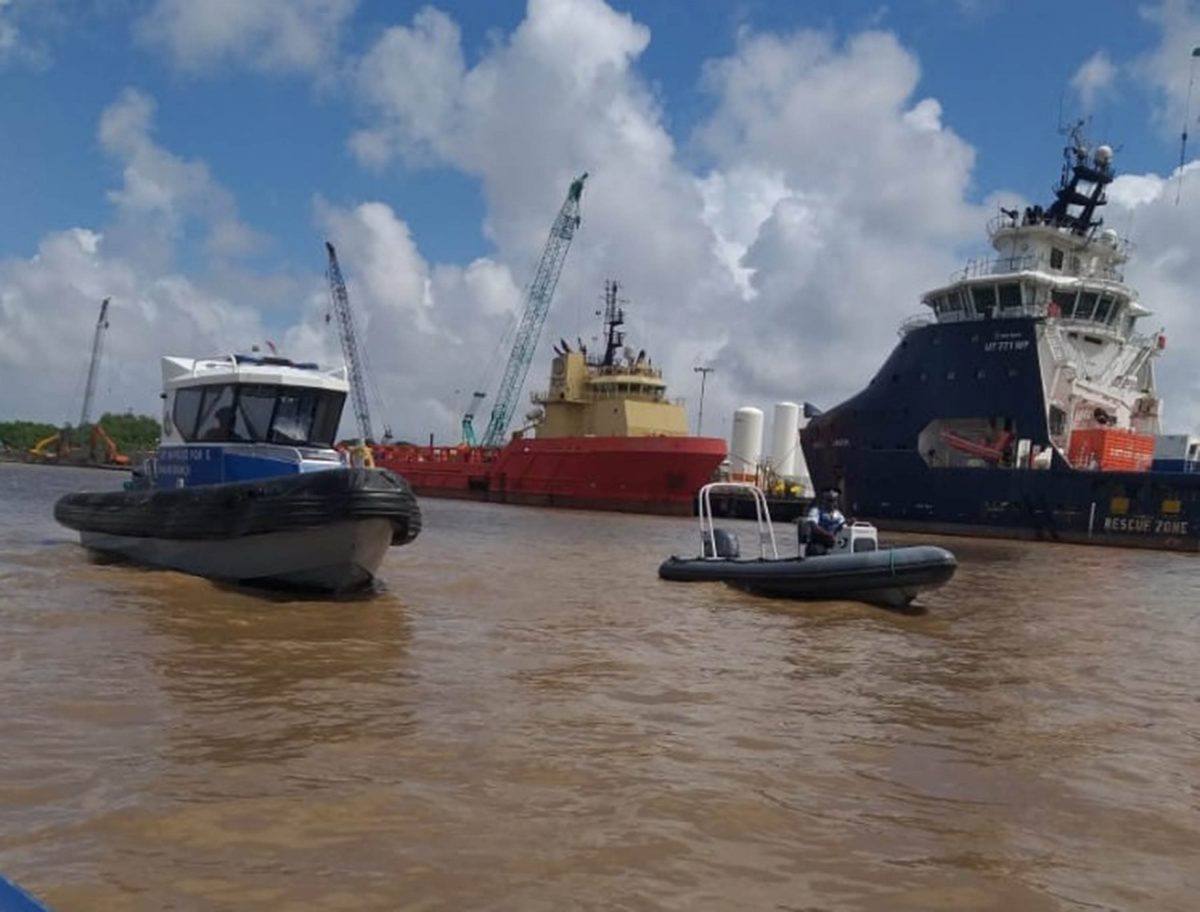Aimed at reassuring citizens and overseas visitors that it’s safe to go about their activities during the upcoming holiday season, the Guyana Police Force (GPF) yesterday unveiled its Christmas policing plan which will see Georgetown being divided into fifteen sectors with day and night patrols.
The plan which began yesterday and concludes on January 15, 2022 was rolled out by Crime Chief Wendell Blanhum, Commander of Region 4(A) Simon McBean and Traffic Chief Ramesh Ashram during a virtual presentation.
Assistant Commissioner McBean said that the plan was compiled based on analysis conducted by the police throughout the year. It entails all forms of policing patrols, the setting up of booths and monitoring of movement through the Safe City Command Centre.

“This plan emphasizes reassurance. We need to reassure the public that they can come to George-town and shop in an environment that is conducive, it emphasizes deterrence, quick policing response, police and public interaction and we hope it contributes to the promotion of positive perception of the police,” McBean said.
During the Christmas season, McBean explained that it is expected that there will be an increase in commercial, economic and social activities with increased shopping and overseas visitors’ arrivals.
As such, he said the country’s capital city, Georgetown is likely to attract a large number of persons creating an increased opportunity for crime, traffic accidents and congestion.
Therefore, McBean explained that in order to ensure a heavy police presence, Region 4(A) has been divided into fifteen sectors each being commanded by an officer or inspector.
He said each sector will consist of foot, bicycle and vehicular patrols.
Foot and bicycle patrols, McBean said will be done between 08.00hrs and 18.00 hours daily while motorcycle patrols will be done between 06.00hrs and midnight.
He added that motor vehicle patrols will occur on a 24-hour basis. The timings, McBean noted will be adjusted to accommodate late shopping.
On a daily basis, McBean stated that it is expected that sixty-four patrols will be in the field. He said that there will be twenty-four foot patrols, twelve bicycle patrols, thirteen motorcycle patrols and fifteen vehicular patrols.
Sector two which covers Robb Street to the north, South Hadfield Street, Camp Street to the east and the Demerara River to the west is expected to occupy most of the resources.
“This is the sector that will take most of our resources, six booths will be in this sector,” McBean said.
River patrols will continue on a daily basis.
In addition, McBean said that there will be heightened intelligence-led operations and continued focus on enforcement of the COVID-19 measures. Special emphasis will be placed on noise nuisance, he added.
The police will be working in close collaboration with the City Constabulary and the business community, McBean said.
He is urging the public to be “alert” and “aware” of their surroundings when shopping in Georgetown. “Carry only what you need……Cell phones are one of the most prevalent things that are taken in our street crimes. If you can shop in groups that will help the situation. Plan your trip ahead. Avoid wearing expensive jewellery and clothing that may draw attention to you. Consider alternative options of payment if you can,” the commander advised.
`Safe city’ monitoring
During his presentation, Blanhum outlined that the police now have full control of the “Safe city” Command Centre and the real time movements of citizens will be monitored.
According to Blanhum, the centre is being manned on a 24-hours basis and information is disseminated to the Commander and officers on patrol duties.
“They are working a 24-hour shift system and information from that centre, real time information is being fed to our commanders and to our patrol officers……From the time a report comes in, the commander would deploy a patrol to that area,” he said.
The project, Blanhum said has been a “very integral” aspect of the police crime-fighting strategies.
He explained that images and recordings were successfully used from the cameras to assist in a number of investigations and for the prosecution of individuals for serious criminal offences.
“We have also managed to secure images of persons committing serious crimes and those images from the Commander Centre were utilized during our court prosecution sessions,” he said.
Just last Friday, President Irfaan Ali announced that the Government plans to expand the surveillance programme countrywide.
The Safe City system is made up of 102 Intelligent Video Surveillance sites, each consisting of three to four cameras, the command centre, which will have the capacity for about 25 agents, two systems that can be mounted on vehicles, as well as three different types of radios and body cameras. Several months after, an additional 17 cameras were installed across the country at crucial locations, such as the Stabroek Market, the Berbice River Bridge and the Lusignan prison.
The cameras are equipped with several features, such as video monitoring systems that aid in the deployment and tracking of law enforcement officers, remote tracking, a facial tracking system, a real time facial recognition and a licence plate location history search system.
The system monitors sections of Georgetown and the East Bank of Demerara. Among some of the areas are Avenue of the Republic, Water Street, Lombard Street, Brickdam, Lime Street and Croal Street.
Blanhum said that the police will maintain a robust presence at choke points, check points and border locations.
He added that there will be heightened patrols in the vicinity of commercial banks, busy shopping areas and night spots.
Additionally, he said the GPF will continue to circulate crime tips through its Public Relations Office and no resources will be spared during this period.
Traffic
Traffic accidents and congestion are likely to increase during this period.
As such, McBean said that the division is expected to have sixty-seven traffic patrols.
Fifty-two of these patrols will be done on foot, fifteen on motorcycles and two on motor cars.
Ashram, who also presented, said that the intention of the force traffic department plan is to ensure free flow of traffic, minimise congestion, accidents and ensure citizens obey all traffic laws.
He said special emphasis will be placed on offences such as driving under the influence of alcohol, speeding and overload of public transportation.
Special arrangements will be put in place on Robb Street, Ashram said. There will be no entry to vehicular traffic going east between Alexander and Albert streets on Robb Street and no entry to vehicular traffic between Regent Street and North Road on Bourda Street.
Special emphasis will also placed on arrivals and departures at the Cheddi Jagan International Airport (CJIA), Timehri and the Eugene F. Correia Inter-national Airport, Ogle.
Ashram added that crash trucks will be operating in Georgetown and its environs on a 12- hour shift system. The trucks, he said will be equipped with wheel clamps for vehicles obstructing traffic and illegally parked.
He further stated that the police will be collaborating with the business community and has proposed specified times for the transport of their goods in containers. “Our proposal is to have these 40 feet and 20 feet containers to operate within Georgetown between the 22.00 hrs and 05.00 hrs daily,” he said.
Ashram urged business owner to have their containers at the terminal and to transport their goods by small vehicles to their business entities. “This will help to reduce congestion within Georgetown and the East Bank corridor a great lot,” he added.






